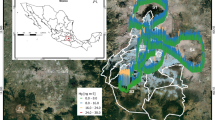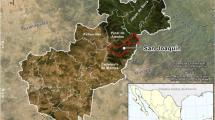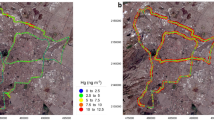Abstract
Atmospheric mercury pollution related to gold mining activities is a matter of concern in the Republic of Suriname. The first measurements of total gaseous mercury (TGM) in ambient air in Suriname at different sites are presented in this study. Our study shows that Suriname has a TGM mercury background level of 1.45–1.52 ng/m3, with a mean of 1.4 ng/m3 which is in agreement with global background concentrations (1.5–2.0 ng/m3) (Feng et al. Sci Total Environ 304:61–72, 2003; Li et al. Sci Total Environ 395:72–79, 2008). Emissions of mercury from gold buy up shops in the City of Paramaribo result in TGM maximum concentrations of 109.4 ng/m3 (15 min average) and a mean concentration level of 5.6 ng/m3 at this urban measurement location. These levels are comparable with that of world cities in Asia and North America. However, per capita Paramaribo loads 3.5–6.5 times more TGM into the atmosphere than Changchun City (Fang et al. Sci Total Environ 330:159–170, 2004) and the occurring spikes are 5.3 times higher and much longer in duration then those in New York City (Carpi and Chen Water Air Soil Pollut 140:371–379, 2002). According to health standard institutions these concentrations represent no risk for the general public. However, a survey inside and in the close vicinity (<100 m) of the gold buy up shops shows mercury concentration levels that surpass the National Institute for Occupational Safety and Health recommended exposure level of 50 μg/m3 inside and the minimal risk level of 0.2 μg/m3 of the Agency for Toxic Substances and Disease Registry outside.









Similar content being viewed by others
References
Carpi A, Chen Y (2002) Gaseous elemental mercury fluxes in New York City. Water Air Soil Pollut 140:371–379
Cordier S, Grasmick C, Paquier-Passelaigue M, Mandareau L, Weber JP, Jouan M (1998) Mercury exposure in French Guiana: levels and determinants. Arch Environ Health 53:299–303
De Kom JFM, van der Voet GB, de Wolff FA (1998) Mercury exposure of maroon workers in the small scale gold mining in Suriname. Environ Res A77:91–97
de la Rosa DA, Volke-Sepúlveda T, Solórzano G, Green C, Tordon R, Beauchamp S (2004) Survey of atmospheric total gaseous mercury in Mexico. Atmos Environ 38:4839–4846
Fang F, Wang Q, Li J (2004) Urban environmental mercury in Changchun, a metropolitan city in Northeastern China: source, cycle, and fate. Sci Total Environ 330:159–170
Feng X, Tang S, Shang L, Yan H, Sommar J, Lindqvist O (2003) (2003) Total gaseous mercury in the atmosphere of Guiyang, PR China. Sci Total Environ 304:61–72
Garcia-Sanchez A, Contreras F, Adams M, Santos F (2006) Airborne total gaseous mercury and exposure in Venezuelan mining area. Int J Environ Health Res 16(5):361–373
Hays P, Vieira R (2007) Mercury contamination, a legacy to handicap a generation. WWF Guiana’s Regional Program Office Technical Paper Series #2
Li P, Feng X, Qiu G, Shang L, Wang S (2008) Mercury exposure in the population from Wuchuan mercury mining area, Guizhou, China. Sci Total Environ 395:72–79
Mohan S, Tiller M, van der Voet G, Kanhai H (2005) Mercury exposure of mothers and newborns in Suriname: a pilot study. Clin Toxicol (Phila) 43(2):101–4
Mol JH, Ramlal JS, Lietar C, Verloo M (2001) Mercury contamination in freshwater, estuarine, and marine fishes in relation to small-scale gold mining in Suriname, South America. Environ Res 86:183–197
Schroeder WH, Munthe J (1998) Atmospheric mercury—an overview. Atmos Environ 32(5):809–822
St Denis M, Song X, Lu JY, Feng X (2006) Atmospheric gaseous elemental mercury in Toronto. Atmos Environ 40(21):4016–4024
Veiga MM, Meech JA (1999) Mercury emissions and stability in the Amazone Region. Des Tromans/University of British Columbia, Department of Metals and Materials Engineering, Vancouver, Canada
Wängberg I, Munthe J, Pironne N, Iverfelt Å, Bahlman E, Costa P, Ebinghaus R, Feng X, Ferrara R, Gårfeldt K, Kock H, Lanzilotta E, Mamane Y, Mas F, Melamed E, Osnat Y, Prestbo E, Sommar J, Schmolke S, Spain G, Sprovieri F, Tuncel G (2001) Atmospheric mercury distribution in Northern Europe and in the Mediterranean region. Atmos Environ 35:3019–3025
Acknowledgments
This research was mainly done as part of the United Nations Environment Program (UNEP) project “Strengthening Surinamese involvement in activities related to mercury pollution in Suriname” (SURIMERC). Furthermore, we acknowledge funding from the EU within the 7th framework project “GMOS”. We are grateful to Cor Becker and his team of the Meteorological Service of Suriname providing the infrastructure for the measurements. The Tekran mercury analyzer was provided by H.E. Scheel (Forschungszentrum Karlsruhe, IMK-IFU, Germany).
Author information
Authors and Affiliations
Corresponding author
Rights and permissions
About this article
Cite this article
Wip, D., Warneke, T., Petersen, A.K. et al. Urban mercury pollution in the City of Paramaribo, Suriname. Air Qual Atmos Health 6, 205–213 (2013). https://doi.org/10.1007/s11869-011-0162-3
Received:
Accepted:
Published:
Issue Date:
DOI: https://doi.org/10.1007/s11869-011-0162-3




